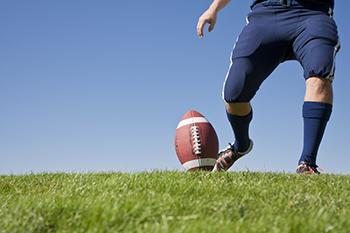 Football players are prone to various ankle injuries due to the sport's high impact and rapid directional changes. Common ankle injuries include sprains, fractures, and Achilles tendonitis. Ankle sprains occur when the ligaments are overstretched or torn, typically from sudden twists or impacts. Fractures result from direct blows or severe twists, leading to broken bones. Achilles tendonitis is the inflammation of the Achilles tendon, often from overuse or repetitive stress. These injuries happen due to the intense physical demands of football, including running, jumping, and tackling. Poor playing surfaces, inadequate warm-ups, and wearing improper footwear can increase the risk. Immediate treatment involves rest, elevation, and compression. Pain relievers and anti-inflammatory medications can help manage pain and swelling. Severe injuries may require immobilization, targeted stretching exercises, or perhaps surgery. Preventing ankle injuries includes proper conditioning, wearing supportive footwear, and performing exercises that strengthen the ankle muscles and improve flexibility. If you believe you have injured your ankle while playing football, it is suggested that you schedule an appointment with a chiropodist for specialized care to ensure a safe return to the field and prevent future injuries.
Football players are prone to various ankle injuries due to the sport's high impact and rapid directional changes. Common ankle injuries include sprains, fractures, and Achilles tendonitis. Ankle sprains occur when the ligaments are overstretched or torn, typically from sudden twists or impacts. Fractures result from direct blows or severe twists, leading to broken bones. Achilles tendonitis is the inflammation of the Achilles tendon, often from overuse or repetitive stress. These injuries happen due to the intense physical demands of football, including running, jumping, and tackling. Poor playing surfaces, inadequate warm-ups, and wearing improper footwear can increase the risk. Immediate treatment involves rest, elevation, and compression. Pain relievers and anti-inflammatory medications can help manage pain and swelling. Severe injuries may require immobilization, targeted stretching exercises, or perhaps surgery. Preventing ankle injuries includes proper conditioning, wearing supportive footwear, and performing exercises that strengthen the ankle muscles and improve flexibility. If you believe you have injured your ankle while playing football, it is suggested that you schedule an appointment with a chiropodist for specialized care to ensure a safe return to the field and prevent future injuries.
Injuries to the foot and ankle are very common among athletes. If you have experienced an injury, please consult with Cynthia Chan, B.Sc., D.Ch from Healthy Advantage Foot & Orthotic Clinic. Our practitioner will assess your condition and provide you with quality foot and ankle treatment.
Common Injuries Among Athletes:
Achilles tendon injuries
Ankle strains or sprains
Plantar fasciitis
Fractures
Turf toe
Joint dislocations
Sever’s disease
Morton’s neuroma
Symptoms
Symptoms will depend on the cause and severity of the injury. Common symptoms for a foot or ankle injury include pain, swelling, tenderness, bruising, a reduced range of motion, and difficulty bearing weight or walking on the affected foot or ankle.
Diagnosis
Sports injuries are typically diagnosed after carefully examining the affected foot or ankle. This includes moving the injured area to test its range of motion. Medical history will need to be provided, as well as detailed information about how the injury occurred. Imaging studies, such as X-rays or MRIs, may be used to confirm or rule out certain diagnoses.
Treatment
Just like symptoms, treatment will depend on the type of injury and its severity. Initial treatment for many sports injuries is aimed at controlling inflammation and promoting the healing response. The acronym R.I.C.E is a helpful guide to implement for most acute injuries. This method involves resting, icing, compressing, and elevating the affected foot or ankle. In addition, anti-inflammatory medications may be administered and orthotic devices may be prescribed. For more severe injuries, surgery may be required. Lastly, rehabilitation or physical therapy may be needed to gain full functionality in the afflicted area.
If you have any questions, please feel free to contact our office located in . We offer the newest diagnostic and treatment technologies for all your foot care needs.